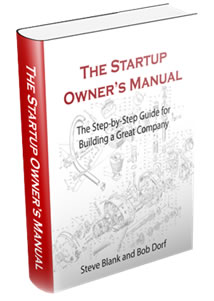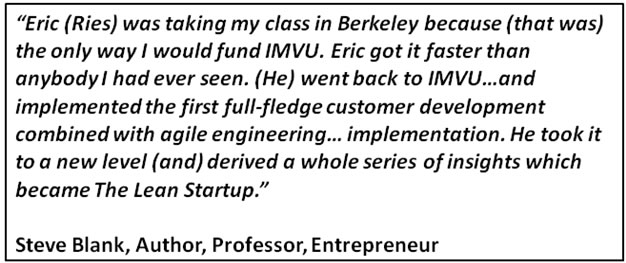Article first published as Steve Blank Discusses Origin And Future Of Lean Startup Movement on Technorati.
 I recently spoke with Steve Blank, author of the new book The Startup Owner’s Manual. Steve is also a Stanford Professor and noted marketing entrepreneur. He is credited with pioneering the Lean Startup Movement in 2005 via the publication of his bestselling, Four Steps To The Epiphany.
I recently spoke with Steve Blank, author of the new book The Startup Owner’s Manual. Steve is also a Stanford Professor and noted marketing entrepreneur. He is credited with pioneering the Lean Startup Movement in 2005 via the publication of his bestselling, Four Steps To The Epiphany.
No matter how much you think you know about Steve’s lean startup philosophy, Eric Ries’ contributions to the movement, or the methodologies by which companies have put lean startup tenets into practice, I am confident you will be enlightened and entertained by Steve’s frank and insightful remarks.
If you haven't already subscribed yet, subscribe now for
free weekly Infochachkie articles!

You can watch / listen to my 20-minute interview with Steve below or on YouTube here: http://youtu.be/UD9BBkbg0ps
Preaching What You Live
The Lean Startup approach dictates that successful customer development is an iterative process. By conceptualizing, selling, gathering feedback and then developing a product, startups achieve success more quickly and economically.
This was exactly the approach Steve took when he self-published Four Steps via Café Press, at the behest of his then star pupil, Eric Ries, Co-Founder of IMVU and the author of The Lean Startup.
According to Steve, “The original version (of Four Steps) was printed on tree bark at Café Press. Eric (Ries) was a student in one of the very earliest customer development classes at Berkley. One of the best students I ever had. Four Steps was essentially my class notes. Eric said, ‘Don’t you know you can put this stuff on Amazon?’ So the fact that it is a badly edited, missing sentences, complete your own and finish your own sentences (book) - basically we can blame it all on Eric. I have to thank him for that.”
I have a copy of the initial Café Press version and I can attest to its rough edges (the book’s first sentence contains a typo). Once the book achieved commercial success, Steve then expended resources to edit and polish the book. It is fitting and instructive that Steve published Four Steps by putting into practice the lean startup methodologies embodied in the book.
Startup Business Plans Are Oxymoronic
Steve notes that in 2005, when Four Steps was published, conventional wisdom at business schools was that, “Startups are nothing more than a smaller version of a large company. That was the implicit statement. Large companies write business plans, why of course, that’s the organizing document for a startup. Ten year later… (we know that) startups are not smaller versions of large companies.
Large companies are organized around execution…so a business plan in a large corporation makes all the sense in the world. Most startups…(are) dealing with a series multiple unknowns. Yet we took this document, the business plan, because we knew nothing else and said, ‘Go write one of these.’
We now know… that startups search for a business model. My definition of a startup is, ‘a temporary organization designed to search for a repeatable and scalable business model.’ If you find one, you become a company. If you don’t find one, you become an ex-company. Customer development, in hindsight… was the first of… an emerging stack of entrepreneurial management tools.”
What’s New In The Startup Owner’s Manual?
Steve’s new book builds upon a number of sources, including: Four Steps, The Lean Startup and Alexander Osterwalder’s Business Model Generation. In specific terms, “the new… book… (leverages) Alexander Osterwalder’s business model generation book as the frontend of entrepreneurs thinking about their business. I now make my students draw Osterwalder’s canvas as the organizing way to think about your hypothesis.”
The other major evolution of Steve’s thinking is in the area of web and mobile businesses, the latter of which were nascent at the time Four Steps was written. In Steve’s words, “the second part is the most obvious, but I didn’t see it at the time (I wrote Four Steps). There is a different speed and a different customer development process, still four steps, but the tactics are radically different for web and mobile apps. You can get feedback almost instantaneously and the cost of iteration is as close to zero as technology will allow us to get. It’s not that the process is different, it’s just that the speed allows you to do some very different things. The new (book) specifically addresses how to build a web and mobile startup and distinguishes the path from physical products to virtual products.”
Enter Eric Ries
I asked Steve to describe Eric Ries’ contribution to the Lean Startup Movement. “Eric was taking my class in Berkeley because the only way I would fund IMVU, the company he was the co-founder of, was if him and his co-founder actually sat through my class…I wanted them to actually sit through this process. Eric got it faster than anybody I had ever seen. (He) went back to IMVU…and implemented the first full-fledge customer development combined with agile engineering. He took it to a new level. He combined customer development and agile engineering in a way that no one had before and out of that, he derived a whole series of insights which became The Lean Startup. He took the lean method past the startup world into a much wider audience.”
Do You Need an MBA To Be A Startup Warrior?
One of my first posts was entitled The MBA Education And Other Oxymorons. MBA’s are frequent targets of derision in the startup world, as their career expectations are often misaligned with the scrappy reality of most venture’s early days.
Steve provides a thoughtful and nuanced explanation as to why business schools often fail when they attempt to teach entrepreneurship. ”My position is fairly radical… that says, 'No.' Most of the things you learn on how to execute (at) a company are actually destructive in the first year or two at a startup; eventually they converge. But you need a different body of knowledge that you will not get as a business school professor consulting for large corporations. This is why entrepreneurship (programs) in universities… are helped when they are taught by adjuncts with startup entrepreneurial experience either as venture capitalists or as retired entrepreneurs.”
As a retired serial entrepreneur and current venture capitalist who teaches entrepreneurship at UC Santa Barbara, I could not agree with Steve more.
I strongly encourage emerging entrepreneurs to seek out all of the books referenced by Steve during our talk, especially the newest of the bunch, The Startup Owner’s Manual.



